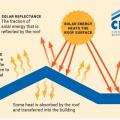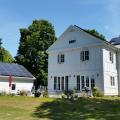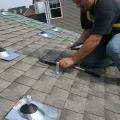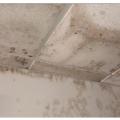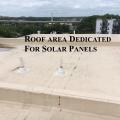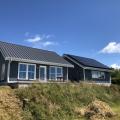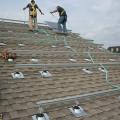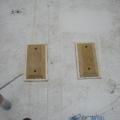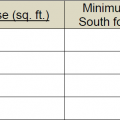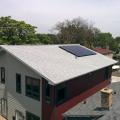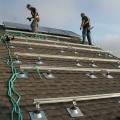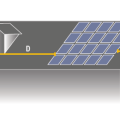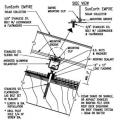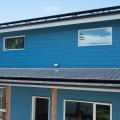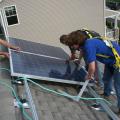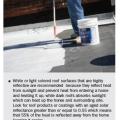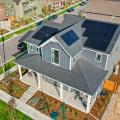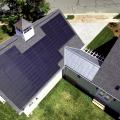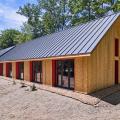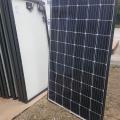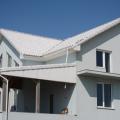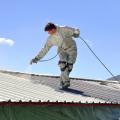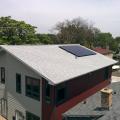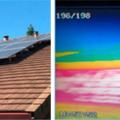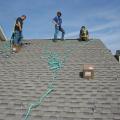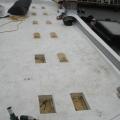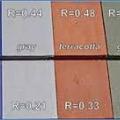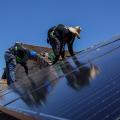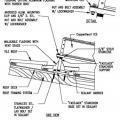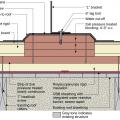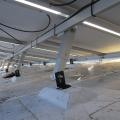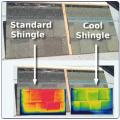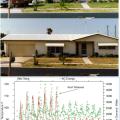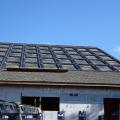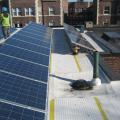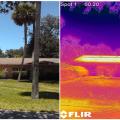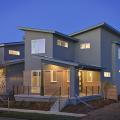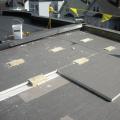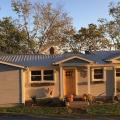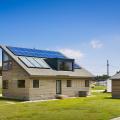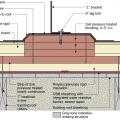Showing results 1 - 54 of 54
A cool roof utilizes materials with high solar reflectance and thermal emittance to reflect solar energy and reduce heat gain to the home
A detached garage offers more space to place solar panels with likely fewer roof penetrations and more options for roof pitch and orientation.
A thermosiphon solar hot water system heats a fluid in the solar collector; the heated fluid heats potable water in a roof top tank.
A waterproof layer of thermoplastic olefin is laid down before installing the solar panels.
All vents are routed to gable walls and eaves rather than through the roof to minimize the risk of leaks and provide an uninterrupted plane for PV panels.
Blocking installed on a flat roof for a PV system rack is sealed around the edges with sealant then will be covered with self-adhering roof membrane to prevent water leakage
ENERGY STAR reflective shingles cover the roof, which is ideally angled for solar panels.
For houses with solar photovoltaic roof panels, any potential shading structure should be twice as far away from the photovoltaic array as it is tall.
Metal cap flashing is installed over the roof parapet and extends down over the roofing membrane
Power production from the Integrated solar shingles helps cut electric bills to $71 a month for this home in North Carolina.
Research by the Florida Solar Energy Center showed that light-colored and reflective roofs reduced cooling energy consumption by 18%-26%, reduced peak energy demand for cooling by 28%-35%, and reduced attic temperatures by 20°F.
Right - In hot climates, paint flat roofs light colors to reflect solar heat gain.
Right - Solar photovoltaic panels are installed on the highest parts of the roof to avoid being shaded by other parts of the house.
Right - The garage roof is correctly oriented for the home’s solar shingle system.
Right - The simple rectangular design of this home provides a large expanse of roof for solar panels.
Right – Angled racks are used for the photovoltaic panel installation on this flat roof.
Right – Photovoltaic solar panels are ready for installation on the roof of a DOE Zero Energy Ready certified home.
Right – This metal roof is being coated with a cool (high SRI) coating to reduce solar heat gain
Roof-mounted solar panels shade the roof below them (left), significantly reducing the roof’s surface temperature (thermal image on the right - yellow region under the panels is cooler than the red and white region on the exposed portion of the roof)
Roofing membrane is installed over polyisocyanurate rigid foam insulation and insulation cover board that has been cut to fit around locations for blocking for the PV system rack
Side by side comparisons of standard roofing colors (top row) and cool colors (bottom row) shows that solar reflectance (R) can be reduced significantly using special coatings with almost no change to the color
Solar panels can be hooked up to batteries to provide emergency power during outages and to help meet daily power needs after the sun goes down
The asymmetrical design of this home offers a large uninterrupted south-facing roof plane for solar photovoltaic and solar thermal panels.
The blocking for a new PV roof-mounting system is integrated with new rigid foam and the air and water control layers installed over an existing flat roof
The blocking is completely flashed with roofing membrane before the PV rack hardware is attached on a flat roof
The cool shingles on the right have been coated with a ceramic coating to reflect near-infrared radiation, resulting in a cooler roof as shown by these thermal images (red and yellow are hotter, green and blue are cooler).
The existing dark tile roof on this home (top photo) was covered with a light -colored coating on day 6 (middle photo), resulting in a significant reduction in attic temperature and cooling energy consumption (bottom)
The photovoltaic panels sit in a waterproof plastic tray that was installed directly on the roofing underlayment, then surrounded with roofing shingles.
The retrofitted flat roof has PV panels and walking mats installed over the roofing membrane
The simple gable roof is constructed at an unusual 6.55 pitch that allows exactly four and a half sheets of 4-foot- wide coated, taped roof sheathing to be installed as the roof deck with enough space at the peak for a continuous ridge vent.
The standard asphalt shingle roof on this Florida home readily absorbs solar energy, allowing it to heat up to 140°F (60°C) as shown in the thermal image on the right
The varied roof pitches offer multiple options for solar panel placement regardless of home orientation for these production homes in Colorado.
The white TPO membrane roof on the row house on the right performs extremely well at reflecting solar energy and maintaining cool surface temperatures while the black EPDM membrane roof on the left heats up rapidly in the sunlight
The wood blocking for future PV panel installation extends above the surface of the top layer of polyisocyanurate rigid foam insulation installed as part of a flat roof retrofit
This home uses light-colored standard paints and finishes on siding and roofing materials to reduce cooling loads without adding material cost.
This home’s south-facing roof provides adequate space for both a solar electric system and solar thermal hot water system.
This search for metal roofing products on the CRRC Rated Roof Products Directory highlights the initial and 3-year aged SRI values for each product
This simplified decision tree can help a homeowner or contractor assess how appropriate a cool roof or wall will be for a particular home
Water management detail for a solar panel rack mounting block installed in rigid foam that was installed over an existing roof
Where the optimal tilt angle for PV panels is 30°, if the roof is facing due south, the tilt angle (roof pitch) can vary 0° to 60° or roof direction can vary up to 65° to east or west and the roof can still collect 90% to 100% of available solar energy.
Wood blocking for future PV panel installation is installed in the layers of polyisocyanurate rigid foam insulation during a flat roof retrofit
